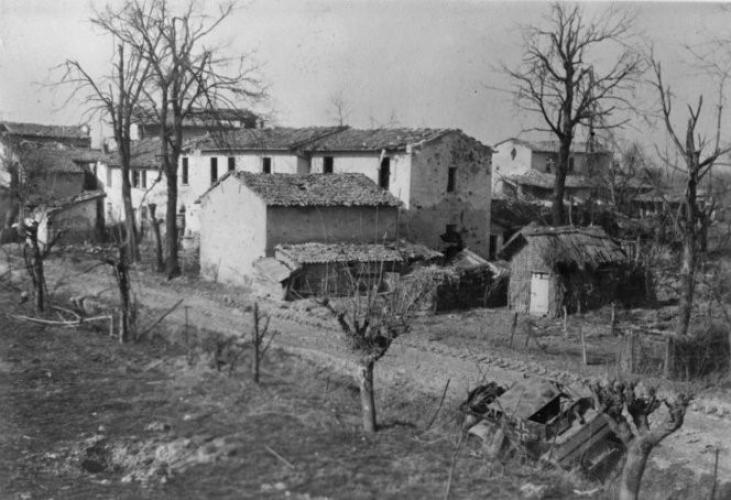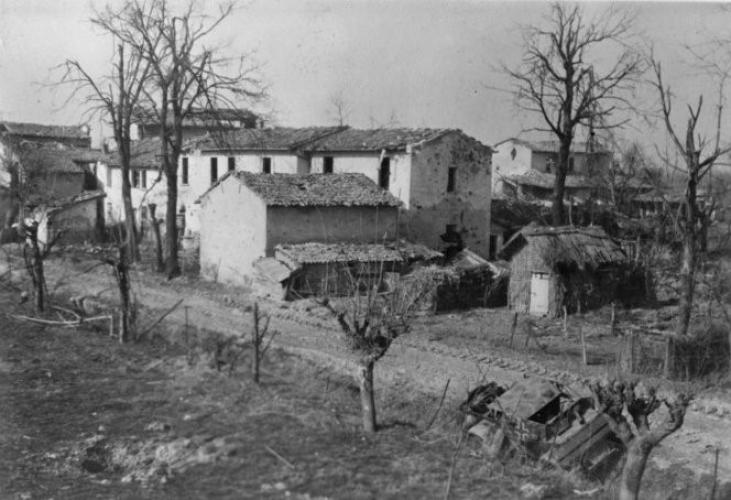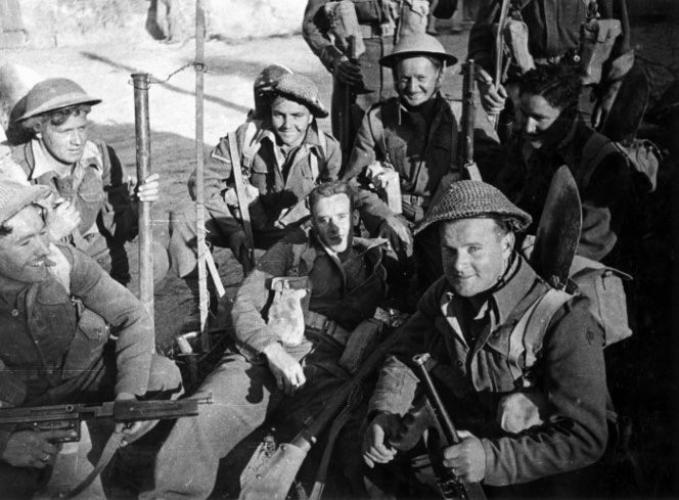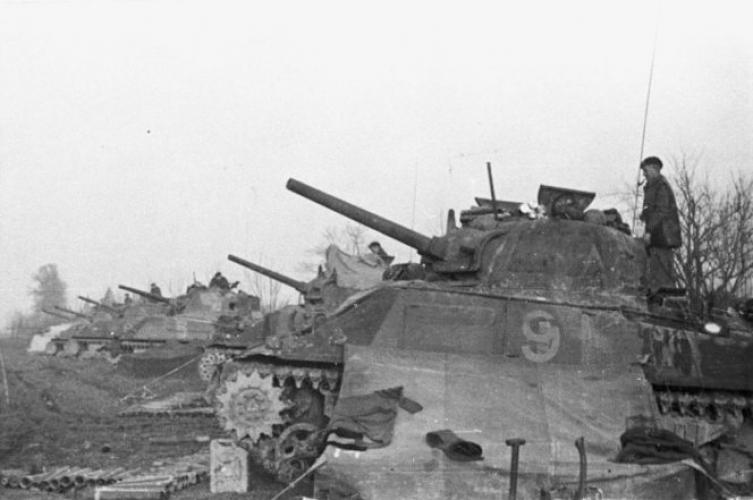066 Senio Gr Upper Hutt, street scene 2018
Reason for the name
The Senio is a 92-kilometre (57 mi) river of Romagna in Italy. The area was the site of several hard-fought battles in the Spring of 1945, during the last phases of World War II in Europe. The Allied crossing of the River Senio was one of the last hurdles that needed to be overcome in order to capture the great Po Valley basin and so complete the campaign in Italy. The German defenders were mostly elite parachute units and, in the very last days of war in Europe, the British 8th Army took many casualties in effecting this defended river-crossing operation.
Senio Grove Trentham is a street within the housing area of Trentham Military Camp. It is normal practice to name such streets are prominent military fuigures or activies.
The Senio river area was the site of several hard-fought battles in the Spring of 1945 during the last phases of World War II in Europe. The Allied crossing of the River Senio was one of the last hurdles that needed to be overcome in order to capture the great Po Valley basin and so complete the campaign in Italy. The German defenders were mostly elite parachute units and, in the very last days of war in Europe, the British 8th Army took many casualties in effecting this defended river-crossing operation.
Author: The Poppy Places Trust
Background
The spring 1945 offensive in Italy, codenamed Operation Grapeshot, was the final Allied attack during the Italian Campaign in the final stages of the Second World War. The attack into the Lombardy Plain by the 15th Allied Army Group started on 6 April 1945, ending on 2 May with the formal surrender of the German forces in Italy.
The Allies had launched their previous major offensive, on the Gothic Line, in August 1944 with the British 8th Army, under Lieutenant General Oliver Leese, attacking up the coastal plain of the Adriatic and the US 5th Army, led by Lieutenant General Mark Clark, attacking through the central Apennine Mountains. Although they managed to breach the formidable Gothic Line defences, they narrowly failed to break out into the Po Valley before the winter weather closed in and made further progress impossible. Their forward formations spent the rest of the winter in highly inhospitable conditions while preparations were made to renew the campaign when better conditions returned in the spring.
Plan of Attack
Clark set out his battle plan on 18 March. Its objective was "...to destroy the maximum number of enemy forces south of the Po, force crossings of the Po and capture Verona." In Phase I the British 8th Army would successively cross the Senio and Santerno rivers and then make a dual thrust, one towards Budrio parallel to the Bologna road, Route 9 (the Via Emilia) and the other north west along Route 16, the Via Adriatic, towards Bastia and the Argenta Gap, a narrow strip of dry terrain through the flooded land west of Lake Comacchio. An amphibious operation across the lake and parachute drop would bring pressure to bear on the flank and help to break the Argenta position. Depending on the relative success of these actions a decision would be made on whether Eighth Army's prime objective would become Ferrara, on the Via Adriatica, or remain Budrio. Meanwhile, it was intended for US 5th Army to launch the Army Group's main effort at 24-hours’ notice from two days after Eighth Army's attack and break into the Po valley. The capture of Bologna was given as a secondary task.
In Phase II, the Eighth Army was to drive northwest to capture Ferrara and Bondeno, blocking routes of potential retreat across the Po. U.S. Fifth Army was to push past Bologna north to link with Eighth Army in the Bondeno region to complete an encirclement of German forces south of the Po. The Fifth Army was also to make a secondary thrust further west towards Ostiglia, the crossing point on the Po of the main route to Verona. Phase III involved the establishment of bridgeheads across the Po and exploitation north.
The Eighth Army plan (Operation Buckland) had to deal with the difficult initial task of getting across the Senio, with its raised artificial banks varying between 6 metres (20 ft) and 12 m (40 ft) in height, honeycombed with defensive tunnels and bunkers front and rear. V Corps were ordered to make an attack on the salient formed by the river into the Allied line at Cotignola. On the right of the river's salient was 8th Indian Infantry Division, reprising the role they played crossing the Rapido in the final Battle of Monte Cassino. To the left of the 8th Indian Division, on the left of the salient, the 2nd NZ Division would attack across the river to form a pincer. To the left of V Corps, on Route 9, the Polish II Corps would widen the front further by attacking across the Senio towards Bologna. The Poles had been desperately under strength in the autumn of 1944, but had received 11,000 reinforcements during the early months of 1945, mainly from Polish conscripts in the German Army taken prisoner in the Battle of Normandy the previous summer.
Once across the Senio the assault divisions were to advance to cross the Santerno. Once the Santerno was crossed, British 78th Division would also reprise their Cassino role and pass through the bridgehead established by the Indians and New Zealanders and drive for Bastia and the Argenta gap, 23 kilometres (14 mi) behind the Senio, where the dry land narrowed to a front of only 5 km (3 mi), bounded on the right by Lake Comacchio, a huge lagoon running to the Adriatic coast, and on the left by marshland. At the same time British 56th Division would launch the amphibious flank attack along Lake Comacchio. On V Corps' left flank the New Zealand Division would advance to the left of the marshland on the west side of Argenta while the Indian Division would pass in Army Reserve.
The Fifth Army plan (Operation Craftsman) envisaged an initial thrust by IV Corps along Route 64 to straighten the army front and to draw German reserves away from Route 65. II Corps would then attack along Route 65 towards Bologna. The weight of the attack would then switch westward again to break into the Po valley skirting Bologna.
Battle
In the first week of April, diversionary attacks were launched on the extreme right and left of the Allied front to draw German reserves away from the main assaults to come. This included Operation Roast, an assault by British 2nd Commando Brigade and armour to capture the seaward isthmus of land bordering Lake Comacchio and seize Port Garibaldi on the lake's north side. Meanwhile, damage to other transport infrastructure having forced Axis forces to use sea, canal and river routes for re-supply, Axis shipping was being attacked in bombing raids such as Operation Bowler.
The build-up to the main assault started on 6 April with a heavy artillery bombardment of the Senio defenses. In the early afternoon of 9 April, 825 heavy bombers dropped fragmentation bombs on the support zone behind the Senio followed by medium and fighter bombers. From 15:20 to 19:10, five heavy artillery barrages were fired, each lasting 30 minutes, interspersed with fighter bomber attacks. In support of the New Zealand operations, 28 Churchill Crocodiles and 127 Wasp flamethrower vehicles were deployed along the front. The 8th Indian Division, 2nd NZ Division and 3rd Carpathian Division (on the Polish Corps front at Route 9) attacked at dusk. In fighting in which two Victoria Crosses were won by 8th Indian Division members, they had reached the river Santerno, 5.6 km (3.5 mi) beyond, by dawn on 11 April. The New Zealanders had reached the Santerno at nightfall on 10 April and succeeded in making a crossing at dawn on 11 April. The Poles had closed on the Santerno by the night of 11 April.
By late morning of 12 April, after an all-night assault, the 8th Indian Division was established on the far side of the Santerno and the British 78th Division started to pass through to make the assault on Argenta. In the meantime the British 24th Guards Brigade, part of 56th (London) Infantry Division, had launched an amphibious flanking attack from the water and mud to the right of the Argenta Gap. Although they gained a foothold, they were still held up at positions on the Fossa Marina on the night of 14 April. 78th Battleaxe Division was also held up on the same day on the Reno River at Bastia.
The U.S. 5th Army began its assault on 14 April after a bombardment by 2,000 heavy bombers and 2,000 artillery pieces, with attacks by the troops of U.S. IV Corps (1st Brazilian, 10th Mountain, and 1st Armoured Divisions) on the left. This was followed on the night of 15 April by US II Corps striking with 6th South African Armoured and 88th Infantry Divisions advancing towards Bologna between Highway 64 and 65, and 91st and 34th Infantry Divisions along Highway 65.[18] Progress against a determined German defence was slow but ultimately superior Allied firepower and lack of German reserves told and by 20 April both corps had broken through the mountain defences and reached the plains of the Po valley. 10th Mountain Division were directed to bypass Bologna on their right and push north leaving U.S. II Corps to deal with Bologna along with Eighth Army units advancing from their right.
By 19 April, on the Eighth Army front, the Argenta Gap had been forced, and British 6th Armoured Division was released through the left wing of the advancing 78th Division to swing left to race north west along the line of the river Reno to Bordeno and link up with the US 5th Army to complete the encirclement of the German armies defending Bologna. On the same day, the Italian National Liberation Committee for Northern Italy, in command of the Italian resistance movement, ordered a general insurrection; in the following days, fighting between Italian partisan and German and RSI forces broke out in Turin and Genoa (as well as in many other towns across Northern Italy), while German forces prepared to withdraw from Milan. On all fronts the German defence continued to be determined and effective, but Bondeno was captured on 23 April. The 6th Armoured Division linked with US IV Corps' 10th Mountain Division the next day at Finale some 5 miles (8.0 km) upstream along the river Panaro from Bondeno. Bolonga was entered in the morning of 21 April by the Eighth Army's Polish II Corps' 3rd Carpathian Infantry Division and the "Friuli" Combat Group of the Italian Co-belligerent Army advancing up the line of Route 9, followed two hours later by US II Corps from the south. On 24 April, Parma and Reggio Emilia were liberated by the partisans.
U.S. IV Corps had continued their northwards advance and reached the river Po at San Benedetto on 22 April. The river was crossed the next day, and they advanced north to Verona which they entered on 26 April. To the right of Fifth Army on Eighth Army's left wing, British XIII Corps crossed the Po at Ficarolo on 22 April, while V Corps were crossing the Po by 25 April, heading towards the Venetian Line, a defensive line built behind the line of the river Adige. As Allied forces pushed across the Po, on the left flank the Brazilian, 34th Infantry and 1st Armoured Divisions of IV Corps were pushed west and northwest along the line of Highway 9 towards Piacenza and across the Po to seal possible escape routes into Austria and Switzerland via Lake Garda. On 27 April, the 1st Armoured Division entered Milan, liberated by the partisans on 25 April, and IV Corps commander Crittenberger entered the city on 30 April. Turin was also liberated by partisan forces on 25 April, after five days of clashes, and on 27 April General Günther Meinhold surrendered his 14,000 troops to the partisans in Genoa. To the south of Milan, at Collecchio-Fornovo, the Brazilian Division bottled up the remaining effectives of two German divisions along with the last units of fascist army, taking on 28 April 13,500 prisoners.
On the Allied far right flank, British V Corps, met by lessening resistance, traversed the Venetian Line and entered Padua in the early hours of 29 April, to find that partisans had locked up the German garrison of 5,000.
Lance-Corporal E.H. Nepia describes the four-hour bombardment prior to the NZ Division's attack across the Senio River, 9 April 1945:
We saw the first of the bombers, flying high in perfect formation, approach at 1340 hrs from the SW, huge Fortresses, like giant silver fish, silver in the bright afternoon sun. Then the roar of the engines, ever increasing as the planes came closer, filled the air. Then they were over and away beyond into enemy territory. Wave after wave passed till the air was filled with a constant, incessant deep roar.
Then, as the first of the waves reached the target areas, a loud hissing accompanied the falling bombs, followed immediately by a deep prolonged rumble, then deep-toned explosions could be heard above the roar of the planes overhead, and, in the wake of these, the reverberations as the earth shook beneath the weight of the bomb loads.
The first bombs fell at exactly 1350 hrs. Liberators came, with their tell-tale twin tail sets; medium bombers, flying lower than the heavies, swept past at a greater speed ... The second wave of bombers was met by white puffs of smoke, indicating that the 88mm AA had at last gone into action. Then black smoke belched from one of the machines, a Fortress. The others flew on. The disabled plane lost speed, then spiralled earthwards, out of control.
Meanwhile a thick pall of smoke hung over enemy territory, where fires had begun their work of destruction, while huge clouds of dust rose as each stick of bombs found their mark.
The last of the bombers had barely disappeared out of sight on the journey home when the thunderous barrage of hundreds of guns of all calibres rained shells on targets beyond and on the Senio.
... For four hours the guns, 25 prs, 4.5s, 5.5s and 7.2s poured shell after shell over the river, while the mortars played a tattoo on the banks, setting off mines and booby traps besides reducing wire defs [defences] to a state easily negotiable by the inf[antry] ... In the dim light, rendered so by the concealment of the sun in the smoke and dust, the Maoris left their positions and section commanders led them to the start line. There were still twenty minutes to go, and by the time all the men were in line a few minutes remained.
... At this moment the Crocodiles and Wasps [flame-throwing tanks] roared fwd [forward] from their posns [positions] of concealment among the trees to the stop bank, mounted the ramps provided, and played long tongues of flame on B bank and beyond ... As soon as the Wasps and Crocodiles moved fwd the infantry left the start line. In a long line, and spaced at intervals of at least ten feet between men, the Maoris crossed the intervening space in a trice, through the low trees, and burst upon the bank just as the Crocodiles and Wasps had ended their phase of operations. Seconds only were required for reaching the top of the bank, and then the men were over, out of sight.








